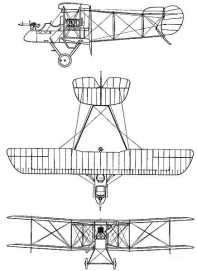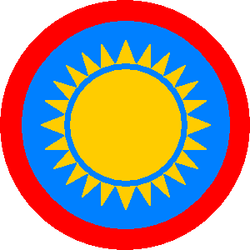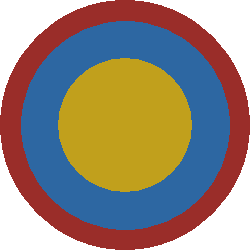IB Turkestan
Air Force of Turkestan

Turkestani Battle Flag
The Air Force was historically the third service to be founded, but is considered senior to the Guards, in part because of the difference in roles. While the Guards do employ several types of ground-launched short-range interceptors, the bulk of Turkestan's military aviation falls within the purview of the Air Force. Airships, long-range aeroplane fighters, ground-strike aircraft and close-support autogiros are all crewed by the Air Force, which also provides all air transportation, including ekranoplans.
The roundel used on Turkestani aircraft belonging to the Air Force is distinguished from the one used by the Guards by the latter's inclusion of a narrow red band around the outside. Despite the defacement of the national flag between 1948 and 1990 by the bürküt (golden eagle) symbol of the Government of National Unity, the various military insignia, including the roundels, remained undefaced.
Comparison of Air Force and Guards Roundels:
History

Baoshan 'Wind Tiger' Fighter
The Turkestani Air Force was founded in 1933 following Turkestan's experience of the effectiveness of air power by being on the receiving end during the attempted Russian invasion of 1931. Turkestan at the time had no air forces at all, and even the single airship that the Russians had was able to bombard the Turkestani ground troops at will, unopposed until the Chinese were able to redeploy enough air cover to the battle zone. After this experience, the Turkestani government were determined to obtain their own aerial combat capability with close enough parity to Russia's Central Asia area forces to serve as a reasonable deterrent.
Thus, in 1933, Turkestan took delivery of its first two airships, the ex-Chinese Long Shan and Long Xu. These airships were already over 8 years old at the time when Turkestan took delivery of them, and were fairly primitive compared to the newest generation of contemporary dirigibles, but they formed the initial core of a brand-new Air Force for Turkestan. The following years saw this core expanded by not only older Chinese airships sold on to Turkestan, but also new construction ordered specially by Turkestan from its main ally, as well as fighter aeroplanes like the Baoshan Feng Hu ("Wind Tiger", known in Turkestan simply as the Yolbars, or "Tiger") fighter pictured here.
Thus, in 1933, Turkestan took delivery of its first two airships, the ex-Chinese Long Shan and Long Xu. These airships were already over 8 years old at the time when Turkestan took delivery of them, and were fairly primitive compared to the newest generation of contemporary dirigibles, but they formed the initial core of a brand-new Air Force for Turkestan. The following years saw this core expanded by not only older Chinese airships sold on to Turkestan, but also new construction ordered specially by Turkestan from its main ally, as well as fighter aeroplanes like the Baoshan Feng Hu ("Wind Tiger", known in Turkestan simply as the Yolbars, or "Tiger") fighter pictured here.




